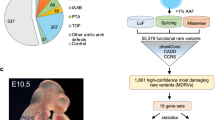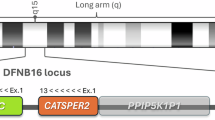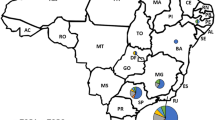Abstract
Desbuquois dysplasia (DBQD) is a severe skeletal dysplasia of autosomal recessive inheritance. DBQD is classified into types 1 and 2 based on presence or absence of hand anomalies. In a previous study, we found a CANT1 (for calcium-activated nucleotidase 1) mutation, c.676G>A in five DBQD families. They were all East Asians (Japanese or Korean). The high prevalence of the same mutation among Japanese and Korean suggested that it is a common founder mutation in the two populations. To examine a possible common founder, we examined the region around CANT1 in chromosomes with c.676G>A mutation by genotyping polymorphic markers in the region for the families. We examined their haplotypes using the family data. We identified in all families a common haplotype containing the CANT1 mutation that ranged up to 550 kb. The two unrelated carriers of the mutation in general populations in Korea and Japan could also have the haplotype. We estimated the age of the founder mutation as ∼1420 years (95% CI=880–1940 years). The c.676G>A mutation of CANT1 commonly seen in Japanese and Korean DBQD should be derived from a common founder.
Similar content being viewed by others
Log in or create a free account to read this content
Gain free access to this article, as well as selected content from this journal and more on nature.com
or
References
Superti-Furga, A. & Unger, S. Nosology and classification of genetic skeletal disorders: 2006 revision. Am. J. Med. Genet. A 143, 1–18 (2007).
Faivre, L., Cormier-Daire, V., Eliott, A. M., Field, F., Munnich, A., Maroteaux, P. et al. Desbuquois dysplasia, a reevaluation with abnormal and ‘normal’ hands: radiographic manifestations. Am. J. Med. Genet. A 124A, 48–53 (2004).
Kim, O. H., Nishimura, G., Song, H. R., Matsui, Y., Sakazume, S., Yamada, M. et al. A variant of Desbuquois dysplasia characterized by advanced carpal bone age, short metacarpal, and elongated phalanges: report of seven cases. Am. J. Med. Genet. A 152A, 875–885 (2010).
Huber, C., Oules, B., Bertoli, M., Chami, M., Fradin, M., Alanay, Y. et al. Identification of CANT1 mutations in Desbuquois dysplasia. Am. J. Hum. Genet. 85, 706–710 (2009).
Faden, M., Al-Zahrani, F., Arafah, D. & Alkuraya, F. S. Mutation of CANT1 causes Desbuquois dysplasia. Am. J. Med. Genet. A 152A, 1157–1160 (2010).
Furuichi, T., Dai, J., Cho, T. J., Sakazume, S., Ikema, M., Matsui, Y. et al. CANT1 mutation is also responsible for Desbuquois dysplasia, type 2 and Kim variant. J. Med. Genet. 48, 32–37 (2011).
Ichida, K., Hosoyamada, M., Kamatani, N., Kamitsuji, S., Hisatome, I., Shibasaki, T. et al. Age and origin of the G774A mutation in SLC22A12 causing renal hypouricemia in Japanese. Clin. Genet. 74, 243–251 (2008).
Risch, N., de Leon, D., Ozelius, L., Kramer, P., Almasy, L., Singer, B. et al. Genetic analysis of idiopathic torsion dystonia in Ashkenazi Jews and their recent descent from a small founder population. Nat. Genet. 9, 152–159 (1995).
Jorde, L. B., Watkins, W. S., Carlson, M., Groden, J., Albertsen, H., Thliveris, A. et al. Linkage disequilibrium predicts physical distance in the adenomatous polyposis coli region. Am. J. Hum. Genet. 54, 884–898 (1994).
Miyake, A., Nishimura, G., Futami, T., Ohashi, H., Chiba, K., Toyama, Y. et al. A compound heterozygote of novel and recurrent DTDST mutations results in a novel intermediate phenotype of Desbuquois dysplasia, diastrophic dysplasia, and recessive form of multiple epiphyseal dysplasia. J. Hum. Genet. 53, 764–768 (2008).
Acknowledgements
We are grateful to Dr Yoshiyuki Yukawa for helping with statistics work. We are grateful to patients, their family members and their doctors for participating in the study. This project was supported by Grants-in-aids from the Ministry of Education, Culture, Sports and Science of Japan (Contract grant No. 20390408), from Research on Child Health and Development (Contract grant No. 20-S-3), from the Ministry of Health, Labor and Welfare of Japan (Measures for Intractable Diseases 046 in 2010) and from the Ministry for Health, Welfare and Family Affairs of Republic of Korea (Korea Healthcare Technology R&D Project; Contract grant A080588). This project was also supported by the Japanese Skeletal Dysplasia Consortium.
Author information
Authors and Affiliations
Corresponding author
Additional information
Supplementary Information accompanies the paper on Journal of Human Genetics website
Supplementary information
Rights and permissions
About this article
Cite this article
Dai, J., Kim, OH., Cho, TJ. et al. A founder mutation of CANT1 common in Korean and Japanese Desbuquois dysplasia. J Hum Genet 56, 398–400 (2011). https://doi.org/10.1038/jhg.2011.28
Received:
Revised:
Accepted:
Published:
Issue date:
DOI: https://doi.org/10.1038/jhg.2011.28



